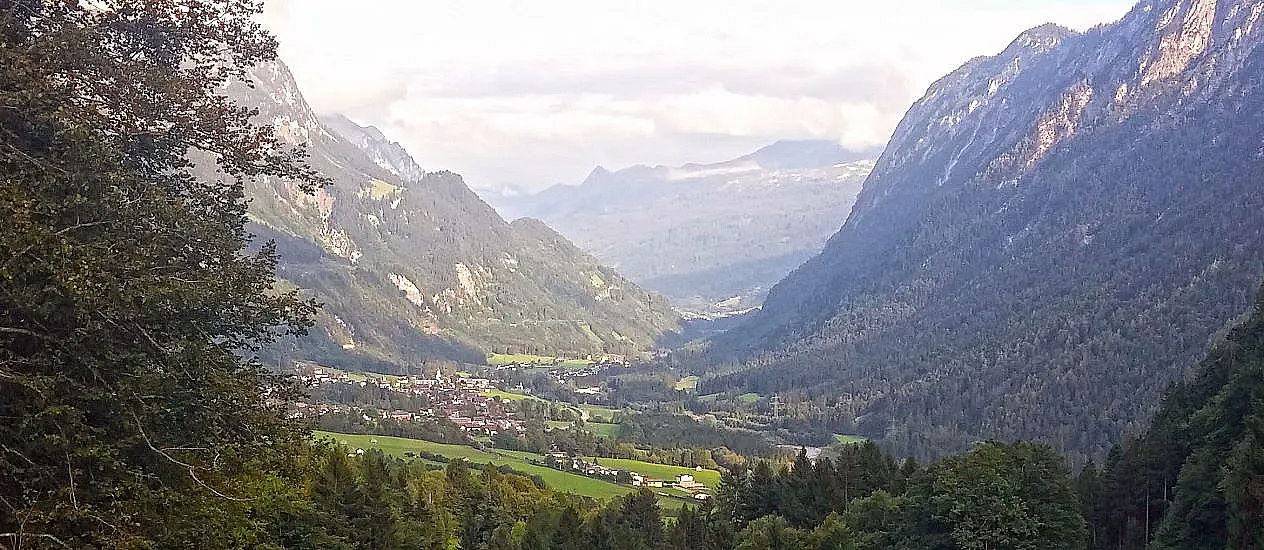Sunna-Weg: Stage 3
From Bludenz to Braz with Christof Thöny, Historian
My hiking companion for the third and last stage of the Sunna-Weg has a professional field of activity that is as diverse as the topics of the Sunna-Weg. He is not only a high school teacher of religion and history, but also an independent project manager in the fields of culture, education and regional development, as well as the publisher of several books. He is the reason why we are allowed to read historically accurate content on the Sunna-Weg today. Christof Thöny hikes with me from Gasünd to Braz over the next hour and a half.
The weather means well with us. After the short rain shower in the morning, sun rays are now drying the path in front of us. We met at the "Klangraststätte" on Gasünd, a new log cabin with a wooden xylophone on which children can live out their musical creativity. We set off, take the left fork into Klostertal and immediately start talking.
How did the themes for the Sunna Trail come about? "When I first looked at the course of the path on the map, some themes emerged as if by magic, such as the history of the settlement at Montikel in Bludenz. Then I started hiking and looked at possible locations along the way and thought about which topic could be explained where." Sounds pretty straightforward. Were there also challenges during the elaboration? "Of course, they arise with any project," Christof answers. "With the Sunna-Weg, the challenge was to depict the region's incredible diversity of topics in an easy-to-understand way. Landscape, social, historical and modern stories wanted to be told. The second challenge was a very banal one, namely to find enough visual material. Particularly historical topics are little documented. But it was still important to me to illustrate the content in addition to the text. People can process images much faster."
I realize how right Christof is when we arrive at the first information board, where the development of the Klostertal is described. Unbelievable how the villages of Wald and Braz have changed since the 1930s! We stop for a moment and let our gaze glide over the meager meadow that lies before us. These meadows are only cultivated once a year and are thus habitats for rare animal and plant species. "That's what makes the Sunna Trail so special," Christof says at this moment. "The trail leads through beautiful landscapes. You discover so much when you get deeper into it. And only then do you realize how many traces people have left behind over the centuries." For another moment, we let the tranquility of nature take effect on us and breathe in the clear mountain air before we leisurely continue on our way.

A small family comes toward us. The son waves his puzzle book and tells us excitedly: "I'm only missing one letter, then I've cracked the solution word of the Sunna-Weg puzzle!" Congratulations are in order! Out of earshot of the family, Christof says, "It's nice that content can inspire kids, too, if we provide the right resources."
With steady steps, we continue on our way. Aside from our breaths, birdsong, and a cowbell in the distance, nothing is audible. I take this moment to ask the last question that is burning my interest. Why is the Sunna-Weg actually called the Sunna-Weg? Christof begins to explain: "We thought long and hard about how we could incorporate the history of the region into the name. Since all three communities used to be part of the Sonnenberg dominion, we came up with the name Sonnenberg-Weg and from there to the somewhat shorter form "Sunna-Weg." This is also the Vorarlberg dialect word for sun. And this name fit wonderfully, because we also hike on the sunny side of the Walgau and the Klostertal." Now I know. And not too soon, because we are just crossing the Allmein above Braz. The first houses are already in sight, three more hairpin bends through the village and we have reached the end point of the stage, the Traube Braz Alpen.Spa.Golf.Hotel. There is still time for a little refreshment in the restaurant before the bus takes me back to Bludenz after an exciting hike.

